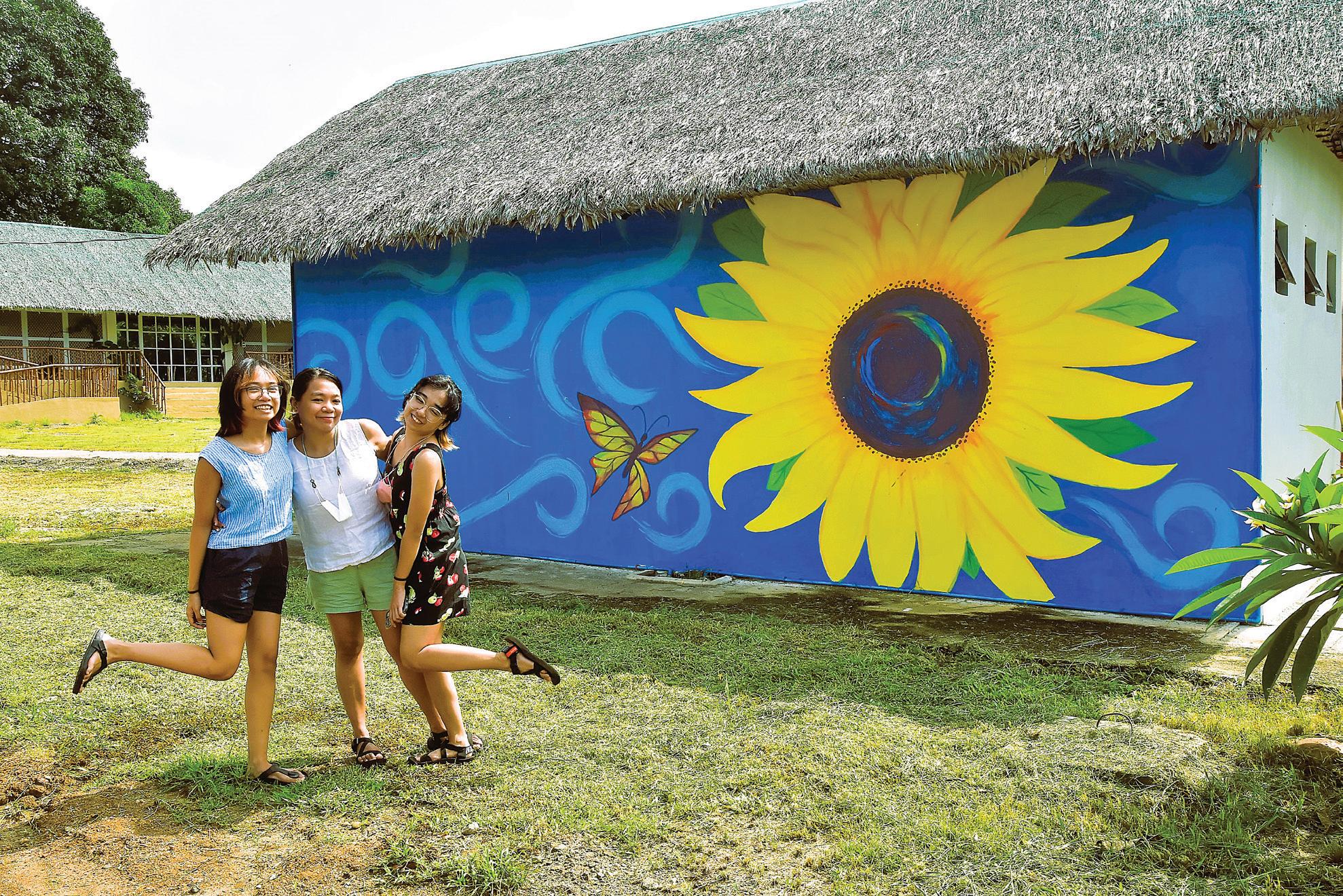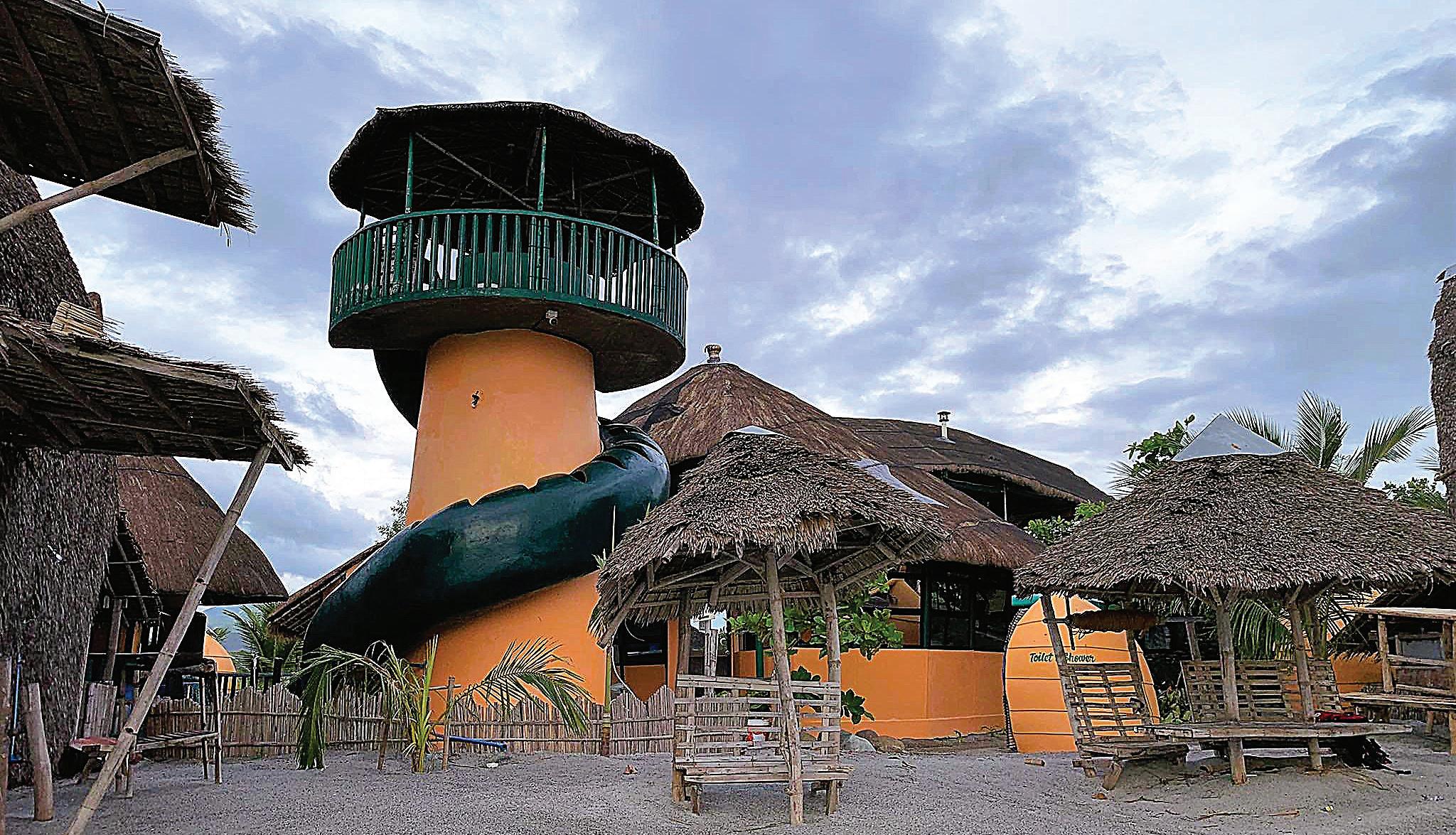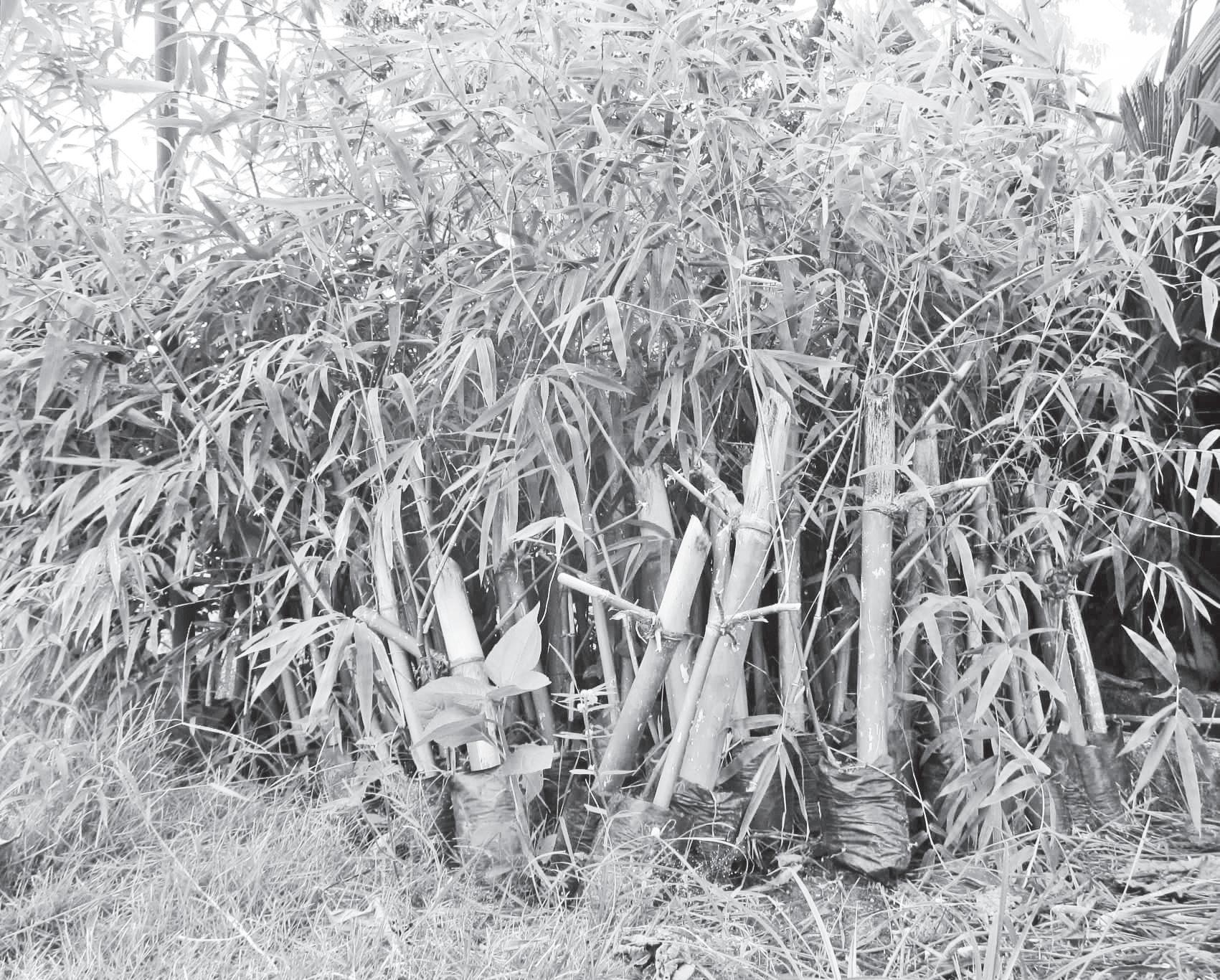SAN




FELIPE, Zambales—Weekends
are a heady time for business at Liwliwa, a beach community that is packing tourists and visitors like the proverbial sardines in this relatively sleepy town of Zambales.



At New Liwa, where a recently built concrete road now gives bet ter access to the beach, pickup trucks and SUVs with surfboards secured on roof racks line up the agoho -lined street, bringing in the adventure class with money to burn. Then at Old Liwa, which pioneered the local board scene with beach camps for backpacking skimboarders, customers continue to be charmed as traditionally bare beach huts metamorphosed into fully furnished glamping hostels.
The clientele is diverse: we saw three young bikers one Saturday at Bali of Liwa, one of the latest ad ditions to the charming Liwliwa beach resorts, lounging on leatherstuffed wickers in a gazebo while waiting for late lunch. At the bar, a couple enjoyed early-afternoon beer while listening to a reggae ver sion of Lady Gaga’s “Remember Us This Way.”
At the footbridge leading to the resort, two girls were snapping pictures and posing with birthday balloons, then momentarily stood
aside to let pass a family of five, bags in tow, who were heading to the cottages.
Bigger groups would come at night, six or eight of either family or friends, most apparently tanned from the beach, when at 7:30 pm, an acoustic duo dished out beer music on an outdoor stage.
Ryan Santos, the resort manag er, said people of all shapes and sizes came to Bali of Liwa since it started operating last April. Most were from Manila, Pampanga, Bataan, Bulacan, and even as far as Laguna.
“They looked for beautiful places, for something Instagram mable, something they can post on social media,” observed Ryan.
Most of those who arrived, Ryan added, were millennials who can’t get enough of the Bali-inspired cottages, the iconic bridge with giant outstretched fingers that spanned

News
PRETTY OPEN SPACES
the river, and the rough-hewn furni ture used throughout the resort.

The same formula of pretty open spaces, where visitors can indulge in leisure with safety at the premium, is tried and tested almost everywhere in Zambales, particularly in tourist destinations where masking is no longer consid ered de rigueur
“They also wanted open spaces where they can feel safe,” said Che Raguini of BCV Farm, a mountain resort tucked amid a grape farm, pa paya-clad foothills, and a cold moun tain-water river in Iba, Zambales.

“People come here because they wanted to enjoy nature, to once again experience not being cooped up because of Covid. People come here because they wanted to feel free,” she added.
Pandemic boom
TOURISM was a big casualty of the Covid-19 pandemic. According to a study by the Congressional Policy and Budget Research Department of the House of Representatives using data from the Philippine Statistics Authority, the growth of the coun try’s tourism industry was halted by travel restrictions, border con trols and stringent community lock downs imposed by the government.
“After 11 years of consecutive growth, the tourism direct gross value added (defined as that generated by the tourism industries of the economy that directly serves visitors) declined by 61.2 percent to P973.3 billion in 2020 from P2.5 trillion in 2019,” the said study noted.
It added that domestic tour ism expenditures, which pertain to
spending by resident visitors within the country either as domestic trip or part of an international trip, “de clined sharply by 77.9 percent and 82.3 percent, respectively, in 2020.”
Local tourism statistics, however, appeared to defy the general trend.
According to the Zambales Provin cial Tourism Office (ZPTO), a total of 503,161 domestic visitors and 17,130 foreign tourists arrived in Zambales from January to June this year.
This was the latest in a continu ing growth from a total of 71,552 local and 1,063 foreign arrivals in 2020, the lowest under the Covid-19 health crisis, to 100,488 local and 3,340 foreign arrivals in 2021 after the plunge. This, from the top record of 692,380 local arrivals and 62,761 foreign arrivals in 2019.
ZPTO, which used the online platform Visitor Information and Travel Assistance System (Zam bales VISITA) to screen out visitors during the Covid-19 pandemic, said that from May 22, 2021, to March 13, 2022, there were 166,312 reg istered users among those wishing to travel to Zambales.
Fully 49 percent of the VISITA users, or a total of 78,849, came from the National Capital Region; followed by Bulacan, with 21,916 (10 percent); Pampanga, with 21,095 (10 percent); Rizal, 10,688 (6 percent); and Zambales, 3,587 (3 percent).
From December 27, 2021, to January 2, 2022, the ZPTO through the Zambales VISITA also recorded 8,299 travel requests to the province, out of which 6,514 were approved.
The most popular destinations requested for visits were the resort towns of San Felipe, San Antonio, and Subic, VISITA data showed.
Double the number STILL, the more telling figures from ZPTO were those that tracked the growth of accommodation es tablishments in Zambales before and during the Covid-19 pandem ic, said Tel Mora, who is Zambales Provincial Tourism Officer.
She pointed out that in 2018, there was a total of 151 accom modation establishments—beach
resorts, inland accommodations, hotels, and lodges or inns. Most of these were found in towns with ac tive beach scenes: 31 in San Anto nio, which is known for its surfing sites; 28 in Iba, the capital town and beach area; 16 in Candelaria, another popular beach site; 15 in Subic; and 14 in San Narciso.
In 2019, the total number in creased to 231, with the most in San Antonio, at 47; Iba, with 42; Candelaria, 23; San Felipe, 19; San Narciso, 18; and Santa Cruz, 16.
In 2020, the total rose to 273, with the most in San Felipe, 48; San Antonio, 46; Iba, 40; Candelar ia, 26; Cabangan, 22; San Narciso, 21; and Botolan, 17.
In 2021, the total further climbed to 317, with the most in San Antonio at 55; San Felipe, 54; Iba, 46; Botolan, 29; Cabangan, 27; Can delaria, 26; and San Narciso, 21.
However, as of August this year, the accommodation estab lishments in Zambales reached a total of 340—more than double that of the 2018 pre-pandemic count of 151. Note that aside from beach resorts, inland accommoda tions and hotels and lodges, three other classifications surfaced: pool resorts, which have a total of 8; farm resorts, now numbering 12; and campsites, now at 10.

Still the beach communities provide the anchor for local tour ism, with the biggest number of tourism accommodation establish ments located in them: San Anto nio with 70; San Felipe, 49; Iba, 42; Botolan, 38; San Narciso, 28; Can delaria, 26; and Cabangan, 25.
Industry revenue
HAND in hand with the growing number of visitors to Zambales and the increase in the number of accommodation facilities in the
province, the local tourism indus try is also experiencing significant growth in tourism income.
Stressing that the Zambales Provincial Tourism Office only counted overnight visitors as “tour ists,” Mora estimated that each tourist has an average stay in the province of two days and one night, especially during the peak tourism season in March until May.
“We’re doing what you can call a conservative count, as we want a reliable measure of performance. We get our figures from local tourism of ficers, not from the establishments,” Mora told the BusinessMirror
She said that with ZPTO es timates placing daily expenditure per tourist in Zambales at P2,500, the 503,161 domestic arrivals and 17,130 foreign tourists recorded from January to June this year could have easily generated more than P1.3 billion in income for lo cal tourism establishments and tourism-related businesses.
From ridge to reef
BECAUSE Zambales has a long coastline—a total of 177 kilome ters of sandy beaches, rocky prom ontories, and mangrove growths— its beaches became the most visible local tourism attractions.
This explains why the top five tourist destinations in the prov ince this year are all situated by the sea: Anawangin Cove in San Antonio town, which logged in a total of 49,044 visitors from Janu ary to June; Nagsaza Cove, also in San Antonio, with 21,686; Talisay en Cove, likewise in San Antonio, with 16,739; Silanguin Cove, in the same town, with 11,706; and Ca pones Island, also in San Antonio, with 4,582 visitors.
Other popular tourist des tinations in Zambales include
the Mount Pinatubo crater lake in Botolan town; Mount Tapu lao, the highest mountain in the Zambales Mountain Range and the highest peak in Central Lu zon, as well as caves, waterfalls, rivers and valleys in between the mountains and the sea.
The newest emerging inland destination that’s taking in visitors in droves is the so-called New Zea land of Zambales, a picture-perfect open space in San Marcelino town that’s actually Rancho Rodri guez. The expanse of green shortcropped grass, the pine trees ring ing the lakeside, and the herd of cattle that freely roam the area are evocative of a pastoral New Zea land scenery, visitors there said.
But other than these, Mora said there’s a lot more that Zam bales can offer. “We have seven ma jor ecotourism sites, seven islands, two museums, and one art gallery. We also have 15 old Roman Catho lic churches, eight national histori cal markers, and one National Cul tural Treasure—the San Andres Apostol Parish Church, which was established in 1697,” Mora added.
Mora said more local tourism offerings will be opened in Zam bales soon with the provincial tourism product launch scheduled this month.
“We are putting out more products in response to Gov. [Her mogenes] Ebdane’s call to identify more local tourism products and services that can compete and pro vide fresh revenue stream to Zam bales,” she said.
These new products, Mora added, will highlight the province’s natural and man-made tourism as sets that capitalize on adventure and lifestyle features. And, yes, all will be very much Instagrammable, she promised.
World
BHP’s plan to keep coal mine open for 93 years ‘delusional’
By James FernyhoughBHP Group Ltd. is seeking ap proval from Australia’s gov ernment to extend the life of a metallurgical coal mine in Queensland for almost a century, drawing the ire of climate groups.
The development application, via a joint venture with Mitsubishi Corp., would ensure the continuation of the Peak Downs Mine “for up to approxi mately 93 years,” according to a filing published by the Australian govern ment. Both BHP, the world’s biggest miner, and the Japanese company couldn’t immediately be reached for comment.
The move comes even after Austra lia’s center-left government vowed to reach net-zero emissions by 2050. The nation’s biggest customers for fossil fuels—including Japan and South Ko rea—have also made similar pledges to dramatically cut their greenhouse gas emissions, while Queensland’s government has promised to close all coal-fired power stations by 2035.

“BHP’s move to extend the Peak Downs coal mine for 93 years to 2116 is delusional,” Harriet Kater, climate lead at the Australasian Centre for Corporate Responsibility, said in a statement Friday. “What part of net zero by 2050 does it not understand?”
Still, both the Queensland and federal government have continued to back the expansion of coal mining, expected to be the nation’s biggest export earner this financial year.
Thirty major coal projects are now awaiting approval from the federal environment minister.
$1-T burden looms for world borrowers refinancing debt
By Finbarr Flynn, Garfield Reynolds & Colin Keatinge
G
OVERNMENTS and compa nies around the world are facing unprecedented costs to refinance bonds, a burden that’s set to deepen fissures in debt markets and expose more vulnerabilities among weaker borrowers.
A corporate treasurer or finance minister looking to issue new notes now would likely have to pay interest that’s about 156 basis points higher on average than the coupons on existing securities, after that gap surged to a record in recent days. That all adds up to about $1.01 trillion in additional costs if all those securities were refi nanced, according to calculations us ing a Bloomberg index tracking some $65 trillion of government and corpo rate debt across currencies.
That broad benchmark of global debt lost 6.8 percent last quarter, its second-worst drop after a record slide in the previous three months, data stretching back to 1999 show. Monday brought little relief, with spreads on Asian high-grade dollar bonds little changed after blowing out the most in six months last week.
Rolling over debt is proving in creasingly tricky for weaker borrowers
as creditors price in risks of a global recession. Most governments and companies are still able to stomach the higher financing bills, but soar ing fund outflows and volatility are causing credit markets to start to buckle. Banks last week had to pull a $4 billion leveraged buyout financ ing, and even investment-grade debt funds suffered one of the biggest cash withdrawals ever.
Actual overall refinancing costs will depend on where rates are when borrowers do roll over debt, and of course many with longer-term obli gations won’t need to do so anytime soon. Still, with the Fed expected to raise its target rate more than a per centage point before year’s end, there’s also a risk borrowers could face even higher costs if they hold off.
Central banks must walk a fine line as they fight some of the worst infla tion in decades, with Bank of America Corp. strategists recently warning that the Federal Reserve needs to slow the pace of rate hikes to prevent credit market dysfunction.
Concerns are also growing that liquidity is draining out of the world financial system as interest-rate swaps—one of the world’s deepest markets—fluctuate wildly. The gap between the floating- and fixed-rate legs of longer-dated swaps tied to the
US Secured Overnight Financing Rate
swung in some recent days by the most on record for the index, which was rolled out in October 2020 as a replacement for the London interbank offered rate.
Six US-based borrowers tracked by S&P Global Ratings defaulted in Au gust, as signs mount that higher rates are already taking a toll on stretched borrowers’ ability to keep issuing new debt to pay off old. Other examples of debt stumbles abound, including in Asia where Sri Lanka defaulted on its borrowings earlier this year, and Chinese property firms have suffered record nonpayments.
“The era of cheap money is cer tainly over,” said Neil Shearing, group chief economist at Capital Economics. “We are at the start of a global reces sion in our view and that includes a recession in Europe, which is particu larly weak.”
Fed bankers dispelled in recent weeks any suggestion they are near halting interest rate hikes even if it means pain for the economy. That’s even after embarking on one of the most aggressive hiking cycles in mod ern times and their third consecutive 75-basis point interest rate increase in September.
The Bloomberg Multiverse Index of investment-grade and high-yield
bonds across currencies has lost about 20 percent this year, on track for its worst annual slump ever. The securi ties fell into their first bear market in a generation in September.
Frontier sovereigns and highly leveraged companies that borrowed in foreign currencies face potentially the greatest stress, according to Shear ing at Capital Economics. While dif ferent in nature, the recent turmoil in UK markets after the government there announced dramatic tax cuts is a “warning” to other governments that they have less room for fiscal maneuver or policy error now, he said.
Higher borrowing costs are pinch ing even the strongest corporations too. The difference between current yields and average outstanding cou pons for both US and European bor rowers is currently around the high est in more than a decade. A sudden chill in US primary markets coinciding with the latest leg higher in yields is evidence that borrowing at current levels is becoming an increasingly unattractive proposition.
“We expect the cost of financing to rise gradually as companies re finance debt with higher coupons as more debt matures over time,” Barclays Plc credit strategists Zoso Davies and Jenny Avdoi wrote in a note dated September 30.
The Fed’s hawkishness is also complicating the task for borrowers because it’s sending the dollar surg ing to multi-decade highs against many of its major peers, including the euro and the yen. That can push up costs for non-US issuers that need dollar financing, as well as tight ening financial conditions around the world.
“Investors had reported record amounts of cash in our most recent quarterly surveys, but recent trading activity suggests an increase in cli ent selling perhaps in part driven by the need to raise additional cash for anticipated redemptions,” emergingmarket strategists including Donato Guarino at Citigroup Inc. wrote in a recent report. “In other words, the cash cushion may be diminishing, making any further market jolt more damaging to asset values.”
The average yield on corporate bonds globally across currencies and ratings recently topped 6 percent for the first time since 2009, according to a Bloomberg index.
“We are yet to see the bulk of the impact of rate rises on the economy,” said Pauline Chrystal, a portfolio man ager at Kapstream Capital in Sydney.
“We still expect to see a deterioration in activity, employment, and increase in defaults.” Bloomberg News
World
What the Russia-Ukraine war means for Asia’s climate goals
By Aniruddha Ghosal & Sibi Arasu The Associated PressNEW DELHI, India—The queues outside petrol pumps in Sri Lanka have lessened, but not the anxiety.
Asanka Sampath, a 43-year-old factory clerk, is forever vigilant. He checks his phone for messages, walks past the pump, and browses social media to see if fuel has ar rived. Delays could mean being left stranded for days.
“I am really fed up with this,” he said.
His frustrations echo that of the 22-million inhabitants of the island nation, facing its worst ever economic crisis because of heavy debts, lost tourism revenue during the pandemic, and surging costs. The consequent political turmoil culminated with the formation of a new government, but recovery has been complicated by Russia’s invasion of Ukraine, and the con sequent upending of global energy markets.
Europe’s need for gas means that they’re competing with Asian countries, driving up prices of fossil fuels and resulting in what Tim Buckley, the director of the think tank Climate Energy Finance, refers to as “hyper-in flation...and I use that word as an understatement.”
Most Asian countries are priori tizing energy security, sometimes over their climate goals. For rich countries like South Korea or Ja pan, this means forays into nuclear energy. For the enormous energy needs of China and India it implies relying on dirty coal power in the short term. But for developing countries with already-strained finances, the war is having a dis proportionate impact, said Kanika Chawla, of the United Nations’ sustainable energy unit. How Asian countries choose to go ahead would have cascading consequences: They could either double down on clean energy or decide to not phase out fossil fuels immediately.
“We are at a really important crossroads,” said Chawla.
Sri Lanka: ‘Slow grind’
SRI LANKA is an extreme example of the predicament facing poor na tions. Enormous debts prevent it from buying energy on credit, forc ing it to ration fuel for key sectors
with shortages anticipated for the next year.

Sri Lanka set itself a target of getting 70 percent of all its energy from renewable energy by 2030 and aims to reach net zero—bal ancing the amount of greenhouse gas they emit with how much they take out of the atmosphere—by 2050.
Its twin needs of securing en ergy while reducing costs means it has “no other option” than to wean itself off fossil fuels, said Aruna Kulatunga, who authored a government report for Sri Lanka’s clean energy goals. But others, like Murtaza Jafferjee, director of the think tank Advocata Institute say these targets are more “aspira tional than realistic” because the current electrical grid can’t handle renewable energy.
“It will be a slow grind,” said Jafferjee.
Grids that run on renewable en ergy need to be nimbler because, unlike fossil fuels, energy from wind or the sun fluctuates, poten tially stressing transmission grids.
The economic crisis has de creased demand for energy in Sri Lanka. So while there are still power cuts, the country’s exist ing sources—coal and oil-fired plants, hydropower, and some solar—are coping.
China, India: Home-grown energy HOW these two nations meet this demand will have global ramifications.
And the answer, at least in the short-term, appears to be a reli ance on dirty-coal power—a key source of heat-trapping carbon dioxide emissions.
China, currently the top emitter of greenhouse gases in the world, aims to reach net zero by 2060, requiring significant slashing of emissions.
But since the war, China has not only imported more fossil fuels from Russia but also boosted its own coal output. The war, com bined with a severe drought and a domestic energy crisis, means the country is prioritizing keep ing the lights on over cutting dirty
fuel sources.
India aims to reach net zero a decade later than China and is third on the list of current global emitters, although their historical emissions are very low. No other country will see a bigger increase in energy demand than India in the coming years, and it is estimated that the nation will need $223 bil lion to meet its 2030 clean energy targets. Like China, India’s look ing to ramp up coal production to reduce dependence on expensive imports and is still in the market for Russian oil despite calls for sanctions.
But the size of future demand also means that neither country has a choice but to also boost their clean energy.
China is leading the way on re newable energy and moving away from fossil fuel dependence, said Buckley, who tracks the country’s energy policy.
“It might be because they are paranoid about climate change or because they want to absolutely dominate industries of the future,” said Buckley. “At the end of the day, the reason doesn’t really matter.”
India is also investing heavily in renewable energy and has commit ted to producing 50 percent of its power from clean energy sources by 2030.
“The invasion has made India rethink its energy security con cerns,” said Swati D’Souza, of the Institute for Energy Economics and Financial Analysis.
More domestic production doesn’t mean that the two coun tries are burning more coal, but instead substituting expensive im ported coal with cheap homegrown energy, said Christoph Bertram at the Potsdam Institute for Climate Impact Research. What was “cru cial” for global climate goals was where future investments were directed.
“The flipside of investing into coal means you invest less into renewables,” he said.
Japan, South Korea: The nuclear option
BOTH Japan and South Korea, two of Asia’s most developed countries, are pushing for nuclear energy after the Russian invasion of Ukraine.
Sanctions against Russian coal and gas imports resulted in Japan looking for alternative energy sources despite anti-nuclear sen timents dating back to the 2011 Fukushima disaster. An earlierthan-expected summer resulted in power shortages, and the govern
ment announced plans to speed up regulatory safety checks to get more reactors running.
Japan aims to limit nuclear en ergy to less than a quarter of its energy mix, a goal seen as overly optimistic, but the recent push indicates that nuclear may play a larger role in the country.
Neighboring South Korea hasn’t seen short-term impacts on ener gy supplies since it gets gas from countries like Qatar and Australia and its oil from the Middle East. But there may be an indirect hit from European efforts to secure energy from those same sources, driving up prices.
Like Japan, South Korea’s new government has promoted nucle ar-generated electricity and has indicated reluctance to sharply reduce the country’s coal and gas dependence since it wants to boost the economy.
“If this war continues...we will obviously face a question on what should be done about the rising costs,” said Ahn Jaehun, from the Korean Federation for Environ mental Movement.
Indonesia: Damage control THE war, and consequent rising gas prices, forced Indonesia to re duce ballooning subsidies aimed at keeping fuel prices and some power tariffs in check.
But this was a very “hurried reform” and doesn’t address the challenge of weaning the world’s largest coal exporter off fossil fu els and reaching its 2060 net zero goal, said Anissa. R. Suharsono, of the International Institute for Sustainable Development.
“We’re sliding back, into just firefighting,” she said.
Coal exports have increased nearly 1.5 times between April and June, compared to 2021, in response to European demand and Indonesia has already produced over 80 percent of the total coal it produced last year, according to government data.
The country needs to nearly tri ple its clean energy investment by 2030 to achieve net zero by 2060, according to the International En ergy Agency, but Suharsono said it wasn’t clear how it was going to meet those targets.
“There are currently no over arching regulations or a clear roadmap,” she said.
Bharatha Mallawarachi in Colombo, Sri Lanka, Edna Tarigan in Jakarta, Mari Yamaguchi in Tokyo, Japan, Tonghyung Kim and Hyung-jin Kim in Seoul, South Korea contributed to this report.
Climate migration: Floods displace millions of villagers in Indonesia
By Dita Alangkara & Victoria Milko The Associated PressMONDOLIKO, Indonesia—All the crops had died and the farmed fish had escaped their ponds. The only road to the village was flooded and the water just kept getting higher, says Asiyah, 38, who like many Indonesians uses only one name.
She knew that she had to leave her home on Java’s northern coast, just as many fellow villagers had done months earlier. So about two years ago, after agonizing over the decision for months, she told her husband it was time to go and started to pack.
Java, home to some 145 million people and the Indonesian capital Jakarta, is the most populated island in the world. Scientists say parts of the island will be entirely lost to the sea in the coming years.
Much has been written about the sinking capital, which is being moved partially due to destructive flooding. Other parts of the country with persistent flooding have received less attention.
Some 300 miles (500 kilometers) from Jakarta, entire villages along the Java Sea are submerged in murky brown water. Experts say rising seas and stronger tides as a result of climate change are some of the causes.
Gradual sinking of the land and development are also to blame.
Mondoliko, where Asiyah is from, is one of those villages.
Asiyah smiles as she describes what Mondoliko was like when she was young: Lush green rice paddies, tall coconuts trees and red chili bushes grew around the some 200 homes people lived in. She and other children would play in the local soccer field, watching snakes glide through the grass while butterflies flew through the air.
“Everyone had land,” she says. “We were all able to grow and have what we needed.”
But around 10 years ago, the water came—sporadically and a few inches high at first. Within a few years it became a constant presence. Unable to grow in salt water, the crops and plants all died. With no land left as the water got higher, the insects and animals disappeared.
Asiyah says she and other villagers adapted the best they could: Farmers swapped their crops for fish ponds; people used dirt or concrete to raise the floors of their homes above the water. Net fences
were put in yards to catch the trash the tide would bring in.
For seven years Asiyah, her husband Aslori, 42, and their two children lived with the floods, the water getting higher every year. But they noticed changes as well: Neighbors were leaving their homes behind in search of drier land. The call to prayer at the village mosque went quiet. Even new fish ponds became futile, the water rising so high that the fish would jump over the nets.
She remembers the day she decided they had to leave her lifelong home. Her father, who lived with them, had been battling bone cancer and prostate issues, and some days he was so frail he couldn’t stand. Her son was getting bigger and faced an increasingly difficult, waterlogged commute to school over 2 miles (about 3 kilometers) away.
“I was worried when the road flooded— how can we go about our daily lives?” she remembers wondering to herself. “The kids can’t go to school or play with their friends.... We
this.”
BHP’s plan to keep coal mine open for 93 years ‘delusional’
Excluding the Peak Downs exten sion, coal from those mines would emit around 17 billion tons of carbon diox ide into the atmosphere over their life times, according to recent estimates by activist group Move Beyond Coal.
That’s more than half of all global emissions in 2021 and would use up 4 percent of the world’s remaining “carbon budget” before atmospheric concentrations of CO2 reach a level where 1.5 C degrees of warming be comes the most likely scenario, the Global Carbon Project has said.
Earlier this year, BHP applied to open a nearby mine, Blackwater South, that could operate for around 90 years.
Chief Executive Officer Mike Henry has previously said that application didn’t necessarily mean the project would go ahead, or continue for that period.
BHP has pledged to reach net zero emissions from its operations by 2050. Still, that figure doesn’t include car bon dioxide released when overseas customers burn coal from the com pany’s mines.
No alternatives METALLURGICAL coal such as that
mined at Peak Downs is crucial to the steelmaking process. It’s widely regarded as more acceptable than thermal coal used in electricity generation, because unlike power generation there are no commer cially viable coal-free alternatives for manufacturing steel.
However, green steel technology, which replaces coal with hydrogen in the iron ore reduction process, has been proven to work, albeit on a smaller scale. HYBRIT, a Swedish joint venture of steelmaker SSAB AB, miner LKAB and power company Vattenfall AB, has already produced fossil-free iron pellets, and plans to have a green steel demonstration plant ready by 2026.
German steelmaker Thyssenkrupp AG is working with BP Plc to develop green steel technology, while iron ore miner Rio Tinto Plc is involved with Australia’s Bluescope Steel Ltd. on a similar project.
But BHP has focused on other methods, such as energy efficiency technology and carbon capture and storage, to help customers reduce their emissions, and has said metallurgi cal coal will be used in steelmaking for decades. With assistance from Chris Bourke/Bloomberg
The best places to visit in Japan before swarms of tourists arrive
By Lily Nonomiya & Chian-Wei TeoAFTER almost three years of Covidinduced border closures, Japan is finally opening up to vaccinated tourists from most countries, with no need for quarantine, PCR tests or visas. And with the yen making hotels, restaurants and shopping more affordable, demand is sure to be high.
Airlines are ramping up flights and businesses are getting to receive visitors from October 11. Even so, it will probably be a while before crowds return, especially with China restricting travel.
With that in mind, here’s are some of the top spots to visit in Japan while the country is still relatively empty, as curated by Bloomberg Tokyo’s newsroom:
Ghibli Park
FOR fans of Hayao Miyazaki’s animated films, it doesn’t get much better than this. Ghibli Park, an ode to the characters and scenery featured in the movies, opens to the public November 1 in Aichi prefecture, roughly three hours by train from Tokyo.
Featuring buildings and landscapes featured in My Neighbor Totoro and Laputa: Castle in the Sky, the park is much bigger in scale than Tokyo’s more modest (but popular) Ghibli Museum. Most of the new attraction will be green space in a 194-hectare (479 acres) park that hosted the 2005 Aichi Expo.
But don’t expect a Cat Bus roller coaster or thrill-seeking rides. Instead, the studio encourages visitors to “take a stroll, feel the wind, and discover the wonders” of the world of Ghibli.
Tickets (reservations required) will cost 1,000 to 2,500 yen ($7-$17) for adults, or 500 yen to 1,250 yen for children, to access any one of the three parts of the park. Two more areas will be added later, including “Mononoke Village.”
Ancient Kyoto NO list of Japan’s travel spots would be complete without mention of Japan’s ancient capital and home to centuries-old temples and shrines, art and exquisite cuisine.
A beloved tourist destination for Japanese and overseas visitors alike, the city of 1.5 million has had a lovehate relationship with its popularity, as its narrow streets and limited public transportation were under strain from heavy tourist traffic pre-Covid. And even if it does get crowded, there are enough offthe-beaten track options to explore, such as the National Museum of Modern Art.
A recent visit to the 1,200-year-old Kiyomizudera Temple overlooking the city saw only a handful of visitors, on a weekday.
There’s new stuff too; Mario fans can visit the former Nintendo Co. headquarters that’s been transformed to a hotel that’s just opened this year complete with a library, bar and spa.
Tokyo’s fish market
MANY returning tourists won’t want to miss out on sushi.
The ramshackle alleys of Tsukiji are no longer home to the world’s biggest fish market, but if you travel a bit further, you’ll find crowd favorites Daiwa Sushi and Sushi Dai at the Toyosu Fish Market at Shijomae station.
Many people in Tokyo will tell you they know the world’s best sushi restaurant.
Ours is Iwasa Sushi, at the new market, where photos of Quentin Tarantino and other celebrities grace the walls. Here, the sushi chefs will lay out a bamboo leaf on the counter and plop down pieces of fatty toro and botan ebi faster than you can wolf it down. Follow the local practice and have a beer or sake with your sushi. For breakfast.
A hiker’s dream
FOR hikers, Japan offers excellent terrain across its mountainous archipelago.
If you’re looking to explore further out of Tokyo, consider Aomori, the northernmost prefecture of Japan’s main island of Honshu. Use JR East Pass to travel up north. Fall is a perfect season to hike in the country, and Aomori’s Mount Hakkoda boasts beautiful fall leaves changing colors during the season. Hikers can opt for a route that ends with a soak at Sukayu Onsen, a famous hot spring by the base of the mountain known for its Senninburo, or “bath of thousand bathers.”
The Michinoku coastal trail runs for over 1,000 kilometers along the Pacific coast of Japan’s Tohuku region. Hikers are rewarded with dramatic scenery of sheer cliffs plunging into the ocean, wonderful sea views and rugged, challenging terrain. Plus the area has incredible seafood.
Iconic Isetan
ONE of Tokyo’s iconic department stores, Isetan in central Tokyo has gotten a facelift since borders were closed at the start of the pandemic.
Originally founded in 1886 as a kimono and clothing store, Isetan has expanded its sprawling cosmetics retail area, which now takes up two floors. That should make it easier to look around and find popular Japanese beauty and spa products, which were a massive draw for Chinese and other Asian tourists pre-Covid.
The Hermès boutique on the first floor also recently expanded but be prepared to wait—lines were already seen there on a recent weekday.
Eclectic Kyushu
KYUSHU, southernmost of Japan’s four big islands, is one of Japan’s best-kept secrets. From top-notch cuisine in the biggest city of Fukushima to the hot springs of Beppu, it’s an increasingly popular destination for travelers, both international and domestic.
Nagasaki, the Kyushu port city that’s home to Japan’s biggest Christian population, is home to numerous churches.
A melting pot, thanks to centuries of trade with the Netherlands, Portugal and China, the city is home to eclectic cuisine and fresh seafood. A short boat ride will take visitors to Gunkanjima, a concrete island that was once home to former coal-mining facility that looks like a battleship.
The new Nishi Kyushu Shinkansen, or eastern Kyushu bullet train, that began service in September should make traveling to Nagasaki much quicker and easier.
With assistance from Bret Okeson, Shoko Oda and Kurumi Mori/Bloomberg
‘Let’s celebrate our rich culture in every whiff’
‘RAISE
the bar and set higher goals for the essential oils industry.”
This was the message given by Science Secretary Dr. Renato U. So lidum Jr. as he challenged essential oils industry partners, government counterparts and funding agencies, while exploring the many opportuni ties to advance it.
This occurred during a recent on line consultative dialogue that gath ered various key players in the local essential oils industry.
Organized by the Department of Science and Technology (DOST), through the Forest Products Re search and Development Institute (FPRDI), the event has the theme, “Investing on the Science, Economics and Sustainability for the Inclusive Growth of the Philippine Essential Oils Industry.”
The event underscored the current status of the sector, and covered issues on the production, processing and mar keting of essential oils, among others.
Former Science secretary Prof. Fortunato T. de la Peña, meanwhile, emphasized the need to continually collaborate with various stakeholders
to “create a globally competitive and sustainable forest flavors and fra grances industry in the Philippines.”
Environment Secretary Ma. Anto nia Yulo-Loyzaga, in a message deliv ered by Assistant Secretary Marcial C. Amaro Jr., recognized the need for science-based strategies to ensure the sustainability of the industry.
Yulo-Loyzaga also assured the indus try of DENR’s commitment on “efforts to harmonize forest policies to sustain ably utilize finite forest products for essential oils.”
Discussions during the dialogue cen tered on the local industry’s best prac tices on sustainability, traceability and socially inclusive development; product and enterprise development, including the use of locally sourced ingredients, such as ylang-ylang, almaciga, kalamansi and sampaguita that are “very Filipino”; and sustainable and responsible sourcing of raw materials that covered initiatives on agarwood and citronella processing and production.
Russell Lorenzo of Casa de Lorenzo Organic Products talked about some of
the challenges in penetrating the global essential oils market, which include the lack of testing facilities specializing in aromatics; locally available equipment; scale and pricing; foreign competitors; hard-to-find local experts; and quality.
Artisan Perfumer Oscar Mejia III of Scentsories Inc., meanwhile encour aged more Filipinos to venture into fine fragrances industry because of the country’s vast natural resource of aromatic plants, and the Philippines’ distinct place in the “world history of fine fragrances.”
“Every scent has a story. Our fra grances are works of art. I hope that in
every whiff, we can celebrate our rich cultural heritage,” Mejia said.
Elizabeth Pahilan of the Depart ment of Trade and Industry-Board of Investments, on the other hand, discussed the promising market pros pects for orange and lemon.
For her part, Oryspa Spa Solutions’ Sherill Ramos-Quintana emphasized the importance of building the Filipi no brand identity: “Export the brand not just the products.”


Meanwhile, DOST agencies pre sented their various R&D, technical assistance and training initiatives on essential oils, including the establish
ment of extraction facilities, and the 2021-2025 roadmap for the Natural Products Program.
DOST shared its support programs that include the Science for Change Program, Start Up Research Grant Program, and the DOST SETUP, which would-be entrepreneurs can tap for their ventures.
“DOST’s goal is to work closely with other national government agencies and help them address the problems of their respective stakeholders. As a research and development institution, DOSTFPRDI continues to provide in
novative and timely solutions to the challenges faced by the vari ous forest-based industries, com munities and stakeholders in the country,” Solidum said.
The consultative dialogue is in line with the institute’s Flavors and Fra grances from the Forest Technology Program (F3TP) that aims to tap under utilized non-timber forest products for food, medicine, flavors and essences.
In the next 10 years, F3TP’s goal is to contribute in creating a globally compet itive and sustainable forest flavors and fragrances industry in the Philippines.
‘Double Helix,’ PHL’s 1st agbiotech mag for senior HS students launched

DOST to feature 12 Balik Scientists in convention

BESIDES the balikbayan, who are Filipinos living abroad and visiting the country, we also have Balik Scientists. They are science experts from abroad who return to the Philippines for a short period, or permanently, to share their expertise to help in the country’s development.
There are currently 12 Balik Scientists in the country. The eighth Annual Balik Scientist Pro gram (BSP) Convention will feature them and their innovations on Oc tober 14.
The Department of Science and Technology (DOST) will lead the event with a theme, “Kasangga sa Paglinang ng Agham at Teknolo hiya para sa Maunlad at Matatag na Kinabukasan,” the BSP said in a news release.
The convention will provide up dates on the recent technologies, research studies and capacity-build ing initiatives that revolve around the research areas of health, agricul ture, aquatic, industry and energy.
The Balik Scientists will present their innovations together with their host institutions, the three sectoral councils of the DOST, namely the Philippine Council for Health Research and Development; Philippine Council for Agriculture, Aquatic and Natural Resources Re search and Development; and Phil ippine Council for Industry, Energy and Emerging Technology Research and Development, the BSP said.
The Balik Scientists and their host institutions from 2020 to 2022 will be recognized during the con vention. The event will likewise be enjoined by potential host institu tions and other stakeholders from different national government agencies.
Similarly, the future plans of the program shall be presented by the DOST, which leads the BSP.
The convention will provide an avenue in increasing the public’s awareness on how Balik Scientists have contributed in addressing na tional concerns, as well as the im pacts of their engagement to the target users, Filipino people, and the economy.

Through technical presentations and panel discussions, the DOST aims to continue the exchange of ideas that will create opportuni ties to build a stronger scientific community.
The program has already en gaged a total of 603 Balik Scien tists under 773 engagements in 130 host institutions from 1975 to August 2022.
Established in 1975, the BSP aims to encourage Filipino scien tists to return to the country and share their expertise.
The program was strengthened in 2018 when Republic Act 11035 was signed, mandating the insti tutionalization of BSP.
During this period, the program came-up with a new Implementing Rules and Regulations and updated the Memorandum Circular 001 se ries of 2021 revamping the exist ing guidelines and provided better incentives to Balik Scientists, the BSP said.
For the first time since the pan demic, the convention will be held in a hybrid setup. Selected participants will join the event onsite, while oth ers can join online via Zoom.
For more information about the BSP Convention, interested parties may visit the DOST-BSP Facebook page at /balikscientist or send an e-mail at bsp@dost.gov.ph.
‘D
OUBLE HELIX ,” the first and only magazine supplement on agricultural biotechnol ogy (agbiotech) for senior high-school students taking the science, technology, engineering and mathematics strand in the Philippines was launched recently.
ISAAA Inc., as part of its Know the Science: Strengthening Biotech Links project with the Philippine Depart ment of Agriculture Biotechnology Program Office, led the launching.
“Double Helix” is a free download able magazine supplement and will be distributed to various senior high schools nationwide.
Magazines have a high impactin classrooms
HIGH-SCHOOL students are always curious about new concepts and ideas. They actively explore their world and discover new things.
Recent developments in agbiotech could be an interesting subject for them, but these should be presented in a format that suits young audiences.
Magazines are excellent supple ments to classroom instruction as they provide students with a variety of information on different topics and activities that allow them to apply the concepts to real-life situations.
An agbiotech supplemental maga zine would provide senior high-school students in the Philippines with a
variety of topics on biotechnology and its benefits to farmers planting biotech corn and activities that are widely available from ISAAA materi als including Pocket Ks, sQuizBox, 50 Biotech Bites, and the most popular and retweeted articles in the Crop Biotech Update.
‘Double Helix,’ the maiden issue
THE world is facing major challenges in food production as the global popu lation increases and climate change severely affects agriculture and food production.
Agbiotech, a field of science that uses modern tools and techniques to
improve crops and livestock, helps address the challenges of feeding and clothing the global population of 9.8 billion by 2050.
As part of its knowledge-sharing initiative, ISAAA developed “Dou ble Helix” for senior high-school students to help introduce them to science and agbiotech.
The eight-page magazine is filled with illustrated stories, infographics and activities to engage the young mind.
The maiden issue of the magazine presents the process of developing a biotech crop, the countries where bio tech crops are grown, biotech crops in the Philippines, Filipino biotech corn farmers, news briefs, and some cool and fun science activities and exer cises for senior-high school students and their teachers to enjoy.
Produced by ISAAA’s Global Knowledge Center on Biotechnology team, it hopes to impart how biotech crops are developed and the immense benefits that consumers, farmers, their families, and communities en joy from planting such crops.
The first feature article of “Dou ble Helix” shows how to genetically engineer plants using the two most common tools—a gene gun and the microorganism Agrobacterium tu mefaciens.
One of the magazine’s spreads is focused on biotech crops in the
Philippines, especially biotech corn, the first biotech crop planted in the country.
The spread also presents Golden Rice and Bt eggplant, two upcom ing commercial biotech crops in the country.
Another spread contains info graphics showing the top four biotech crops and the 29 countries planting biotech crops worldwide. The global map shows the adoption of commer cialized biotech crops in 29 countries.
The other half of the spread con tains quotes from Filipino farmers sharing their experiences and telling how planting biotech corn improved their quality of life.
The magazine’s pages have QR codes and links to information mate rials published on the ISAAA website that are related to the feature articles.
The “Double Helix” magazine is free to download from the ISAAA web site.
It is also free to use, and interested high schools can contact the ISAAA team if they want to use the maga zine in their instruction.
A Teacher’s Companion material that includes a guide to related ISAAA publications and suggested quizzes on specific topics is also available to help teachers navigate the magazine’s pages.
For inquiries, please send an e-mail to double.helix@isaaa.org
Chinese Gen. Hosp. now has Da Vinci robot in its surgical team
IN line with its commitment toward medical advancement and tech nology, Chinese General Hospital and Medical Center (CGHMC) recently unveiled its brand-new, recently ac quired Da Vinci Surgical Robot.
The highly advanced, robotic-as sisted surgical system is said to en able doctors to perform many types of complex procedures associated with minimally invasive surgery (MIS) with more precision, flexibility and control than with conventional techniques, said CGHMC in a news release.
The Da Vinci model procured by CGHMC reportedly moves in real-time and like a human hand but with a great er range of motion. Surgeons control it via a console and can deliver highly magnified (up to 10 times), 3D highdefinition views of the surgical area.
This is the latest program of the hospital that is geared toward its in novative expansion, as part of its 130th anniversary celebration last
the country.
surgical
The smaller incisions mean lesser tissue invasiveness, lesser pain, lesser blood loss, and lesser scarring.
Robotic-assisted surgery is still relatively new in the country, and reportedly only a handful of medical institutions are equipped with such.

The hospital added that this is a more advanced form of MIS, similar to laparoscopic surgery in principle, but utilizes a more advanced way to carry out the procedures.
In contrast to traditional open sur gery that requires long skin incisions, robotic surgery utilizes only 5mm to 12 mm incisions, allowing small di ameter instruments access into the body, thus, supposedly eliminating the degree of invasiveness.
a more
robotic-assisted
claimed to benefit patients with a
as it is per formed through tiny incisions.
CGHMC claims that the Da Vinci Robot System also ensures more af fordable surgical procedures for the Filipino and Chinese-Filipino com munities nationwide, the news re lease said.
Sunday
Caritas to organize ‘champions’ of good governance in parishes
ACHURCH-LED grassroots movement will organize advocates in parishes across the country who will act as “champions” of good governance and nation-building.
Caritas Philippines announced the plan during the recent launch ing of its “Simbayanihan” move ment, a “whole-of-Church” ap proach to address poverty and corruption.
“So among our next moves is to organize good governance ad vocates in different dioceses and parishes,” Caritas Executive Sec retary Fr. Tony Labiao said. “We have to organize communities.”
“We need to organize the working teams who will lead the engagements for economic em powerment and participation in local governance,” said the priest, who is also the national convenor of Simbayanihan.
The launching was preceded with the first Simbayanihan Na tional Congress at the Caritas Philippines Academy in Tagaytay City, south of Manila.

The whole-day event was at
tended by representatives from different diocesan social action centers across the country.
The national Caritas said the program also aims to form and support principled politics and politicians and create “critical vigilance” among communities.
Its National Director Bishop Jose Colin Bagaforo said the pre vious elections taught them that “we failed in our old strategies” to bring people together to discuss politics and development.
“Simbayanihan was hoped to bridge the gap between faith and justice, by taking part in concrete social action works on ecology, justice and peace, and good gov ernance,” Bagaforo said.
Fr. Rex Paul Arjona, one of the convenors of Simbayanihan, said the movement is focused on linking existing good governance and community development
programs through organization and partnership building, train ing and formation for responsible citizenship, and principled coop eration with government.
Besides the Caritas network, Agri Partylist, the Quezon City government, and the People Pow er Volunteers for Reform are also part of the convening groups.
“We always believe in the in fluence of the church to effect community empowerment and development, which is vital in en suring that government programs are enforced properly and maxi mized fully,” said Agri Partylist
Rep. Wilbert Lee.
“We are working with Caritas Philippines and our partners to pro vide communities with sustainable economic activities so we will be able to help create empowered commu nities who can exact accountability among local and national politi cians, and be more engaged in local governance,” Lee added.
Simbayanihan will be launched at the regional and diocesan lev els in the coming months, in volving the civil society, govern ment, and private organizations, through the social action clusters and centers.
PRISON MINISTRY EXEC: ANTI-DEATH PENALTY LAWMAKERS LACK NUMBERS
ANTI-DEATH penalty advocates in Congress are clearly at a disadvantage, the Catholic Church’s prison ministry office admitted.
While the House of Representatives is dominated by allies of the ruling administration, Gerry Bernabe of the Episcopal Commission on Prison Pastoral Care (ECPPC) said they only have four “sure allies” in the Senate so far.
“It’s challenging these days but I believe, because we are on the right side, we can do this fight,” said Bernabe, who is also a Volunteers in Prison Service (VIPs) national coordinator.
“As the struggle against death penalty will go on, let us remain vigilant and stand for what is right,” he said.
Bernabe made the statement after a Mass at the CBCP chapel in Manila’s Intramuros district for the World Day Against Death Penalty, which will be observed on October 10.
The liturgy was presided over by Fr. Eli Rowdy Lumbo of the Philippine Jesuit Prison Service, with CBCP secretary general
There are currently about six pending measures before Congress that seeks to restore the capital punishment in the country: four of them were filed in Senate and two in the House of Representatives.
In a statement, ECPPC Chairman Bishop Joel Baylon renewed their opposition to any moves to revive the death penalty under the Marcos administration.
Among other reasons, he said that the death penalty “will only victimize the poor” that lacks access to quality legal services and that it cannot work in an “imperfect judicial system like ours.”
“Thus, we strongly and unequivocally oppose moves in the present Congress to restore the death penalty in our justice system,” Baylon said.

The bishop called on legislators to instead pass laws that will make the country’s criminal justice system “more pro-life and pro-poor, more restorative and not merely punitive.”
“Let us affirm our option for life,” he said. CBCP News

after the 1979 Iranian Revolu tion, which spurred Iran’s rise as a regional power and prompted Saudi Arabia to try and compete.
An austere school of Islam, Wahhabism often encourages the literal interpretation of the Quran and is especially suspicious of any practices they see as idolatry.
For example, Saudi authorities have clamped down on worship at saints’ tombs and razed some holy sites entirely.
In extreme cases, Salafis— a related school of Islam—have claimed that the relics and stat ues of ancient Egypt should be destroyed.
In Saudi Arabia, the religious police, called mutaween, guard the prophet’s burial grounds in Medina during pilgrimage seasons to prevent visitors from touching it or praying close to it.
Jews see healing, renewal in Yom Kippur amid hurricane
FORT MYERS, Florida—
Even though a destructive hurricane tore through his community just days earlier, nothing was going to stop Rabbi Yitzchok Minkowicz from hold ing prayer services for the start of the holiest day on the Jewish calendar.

MOST Muslims celebrate the birth of the Prophet Muhammad on the 12th day of the third month of the Is lamic calendar, Rabi’ al-awwal— which starts on the evening of October 7 and ends the following evening in 2022.
Muslims view the celebration, called Mawlid al-Nabi, or simply the Mawlid, like many other Is lamic celebrations: as a sign of respect and adoration of Muham mad, whom they believe to be God’s messenger.
According to Muslim tradi tion, Muhammad was a righ teous man born around A.D. 570, whom God designated as His final prophet. He learned God’s message by heart and recited it.
Later on, the verses were writ ten down to preserve the text— what is now the Quran.
Most countries with major ity Muslim populations, from Pakistan to Malaysia to Sudan, commemorate the prophet’s birthday each year. The most colorful celebrations are carried out in Egypt, with Sufi dhikr po etry commemorating the proph et, and games, toys and colorful sweets given to kids.
Yet not all Muslims mark the holiday. In a few countries, like
Saudi Arabia, it’s just like any other day.
The focus of my research is how Muslim societies relate to their faith, including their sense of so cial justice and their expectations of governments.
While most Muslim countries encourage commemorating the Mawlid, the opposite is true in communities shaped by the ultraconservative Wahhabi school of Islam, whose global influence has rapidly expanded in recent de cades.
Wahhabi disapproval
THE Wahhabi movement was started in 1744 by Muhamed Ibn Abdel Wahab, a religious scholar and reformer in what is today Saudi Arabia.
Muhamed Ibn Saud, a political leader considered the founder of the Saud dynasty, legitimized his authority by seeking Ibn Abdel Wa hab’s religious opinions. Ibn Saud was eager to wrest more power from the Ottoman Empire, which controlled much of the peninsula at the time.
Since then, Wahhabism has spread across the Muslim world in countries—such as Yemen, the post-Soviet states, Tunisia and Egypt—especially
Conservatives frown upon ado ration of the prophet. Wahhabi pu ritans consider the Mawlid hereti cal, citing a saying of the prophet, called a hadith: Every heresy is a misguidance, and every misguid ance will end in hell.
The word for “heresy” here, “bid’ah,” is often used to condemn Muslim practices seen as innova tions, like celebrating the proph et’s birthday.
Celebrating with awe CRITICS of Wahhabism argue that it compromises people’s rela tionship with God by cutting off instinctual human behavior, like wanting to honor a prophet.
As opposed to the literal and conservative focus on the one ness of God, which Wahabis em phasize, most Muslims observe the prophet’s birthday as a sign of love, respect and awe.
The Mawlid is celebrated in many ways and forms in the Mus lim world, whether it is quietly observed by fasting and reading the Quran, or by kids dressing up in bright colors and getting a tiny horse or a doll made out of sugar.
The practices vary, but the one thing they articulate are the ad mirable qualities of the prophet and how dear he is to his followers.
Deina Abdelkader, University of Massachusetts
Throughout a southwest Flor ida devastated by Hurricane Ian, Jews planned to hold worship services for Yom Kippur, a day in which they fast for 24 hours (from the evening of October 4) and ask forgiveness for the wrongs they have committed during the year, although many were doing so with plans drastically modi fied by the storm.
Some congregations were skipping in-person attendance for the all-important Kol Nidre service on Tuesday evening out of concern it would be too dan gerous to drive at night with debris piled up on roads and traffic lights out. Others were holding it online.
At Minkowicz’s synagogue, the religiously traditional Chabad Lubavitch of Southwest Florida in Fort Myers, members planned a community dinner before fasting was to start at sunset on Tuesday, with the help of caterers from South Florida, on the other side of the state.
Some buildings on the 5-acre campus were flooded. But the main building, where 50 or so people sheltered during the hurricane, was comparatively unscathed because of its higher elevation.
Power returned on Sunday night, and the campus had turned into a community center of sorts, with food trucks and a food pan try. A large tent was erected in the parking lot where members of the synagogue—or anyone from the community—could stop by for a meal.

“The most important thing
we have is to make God happy,” Minkowicz said. “If God is happy, everything works out.”
At Temple Beth El in Fort My ers, congregants planned to have in-person Yom Kippur services on Wednesday, with Kol Nidre services available only online Tuesday night.
However, plans had been in flux at the congregation, which is part of the progressive Reform movement, since utility trucks were using the parking lot as a rest area for utility worker breaks. The trucks were expected to be gone by Wednesday’s services.
Rabbi Nicole Luna said con gregants should consider their safety when deciding whether to attend in person. Some of the congregation’s more than 250 families lost their homes.
“People are shattered and in need both of resources and sup plies, but also of community and hope,” Luna said.
Rabbi Lawrence Dermer and his wife, Robin, decided not to hold a Kol Nidre service on Tues day night at their synagogue, Shalom Life Center, out of con cerns about the safety of their congregants.
The evening service marks the start of the holiday with a chanted prayer asking to be re leased from all obligations that
can’t be fulfilled.
“We didn’t want to encour age anyone to go out after dark. The roads are hazardous and in some areas there’s still a cur few,” said Lawrence Dermer, who leads the congregation, which welcomes members from all Jewish backgrounds.
Shalom Life Center planned to hold daytime services on Wednesday but was skipping holding a traditional community “break fast” in evening, when Jews indulge with bagels, lox, whitefish and other staples fol lowing 24 hours of not eating. That will be postponed for a few weeks, until the community gets out of the crisis mode from the storm, Lawrence Dermer said.
The Fort Myers metro area has around 7,500 Jews, and the Naples area further south has an additional 7,500, according to estimates published in the 2020 American Jewish Year Book.
Compared with other parts of the state, the Jewish community in southwest Florida is relatively new, with the oldest congrega tion, Temple Beth El, formed only in 1954 with 22 families.
Rather than making them ques tion their religious convictions, the ferocious storm has renewed the faith of many members of their congregation, said Lawrence Dermer and his wife.
During the 10 days between the Jewish new year, Rosh Ha shanah, and Yom Kippur, Jews traditionally say to one anoth er, “May you be inscribed in the Book of Life,” in what is almost an entreaty that they be blessed with another year of life.
“Yom Kippur is about the fra gility of life. If anything, we have seen with ‘Ian’ how precarious life is,” said Robin Dermer. “The mean ing of Yom Kippur, of renewal and connection to God, will be deeper, not lessened.”
Caina CalvanWhy not all Muslims celebrate Mawlid, the Prophet Muhammad’s birthday
Biodiversity Sunday
‘Construction material of the future’
By Jonathan L. MayugaMORE and more Filipinos are becoming interested in planting the once known as “lowly bamboo” as it is making a big comeback in housing construc tion, some even calling it the “grass of hope.”
This giant grass species has been used for generations by Filipinos in building their traditional bahay kubo, or nipa hut.
They make use of bamboo poles to construct bridges, foundation for big structures and braces, walls or perim eter fences.
It is also used to make tables and chairs and other furniture.
However, the popularity of bamboo was diminished by cement and other durable construction materials, such as steel, fiberglass and plastics.
Resurgence
IN recent years, bamboo has become popular again and is even widely ac cepted for interior design even among professional builders.
This realization, plus the fact that bamboo is easy to grow, is helping improve the condition of river banks, prevent soil erosion and flooding.
It prompted the government to identify bamboo as “a must” planting material for the National Greening Program to promote its massive cul tivation and maximize its potential.
In June 2022, President Duterte signed Proclamation 1401 declaring September as the Philippine Bamboo Month.
Promoting bamboo
LAST month, a global leader in bam boo-based research and technology, Base Bahay Foundation (Base), kicked

off the celebration with a session in an Architecture and Design Forum series, called “Bamboost,” that high lighted green technology and the use of bamboo in construction.
Professional builders and bamboo enthusiasts converged at the Green Sun in Makati City to hear local and in ternational experts in the field speak on local and international bamboo architecture and design.
Of course, they promote bamboo as a construction material.
Learning series
THE Bamboost Architecture and De sign Forum was part of Base’s learn ing series for bamboo construction enthusiasts.
The foundation has been conduct ing free training programs for profes sional builders, such as architects and civil engineers, under its Continu ing Professional Development (CPD) learning series.
It gives a head start in anticipation of the standardization of bamboo con struction and design and mainstream ing of bamboo in building codes.
Base is working with the Associa tion of Structural Engineers of the Philippines (Asep) to include bamboo in the next version of the National Structural Code of the Philippines.
Alternative building technologies
AN initiative of Liechtenstein-based Hilti Foundation, Base continues to provide alternative building technolo gies to enable a network of partners to build quality socialized homes that are comfortable, affordable, disasterresilient, ecologically friendly, and with social impact.
To date, Base has built more than 1,000 homes using its proprietary Cement-Bamboo Frame Technology,
sheltering about 5,000 individuals in 14 communities across the Phil ippines.
Internationally, Base is pipelined to build disaster-resilient houses in Nepal.
Bamboo experts
SPEAKERS during the forum include Jörg Stamm, a Colombia-based bam boo construction specialist and train er. He is widely known for his design and construction of engineered bam boo structures in different countries.
Other speakers were Munir Vahan vati, Ray Villanueva, Christian Salan danan and Base Head of Technology Luis Felipe Lopez.
Munir Vahanvati, an architect and urban designer who has worked with bamboo for over 15 years on a wide range of projects in product and build ing design, large-scale infrastructure and urban regeneration projects, is co-founder of Green Grass. He is fo cused on community development using bamboo.
Meanwhile, Filipino-American architect Villanueva is co-founder of the Kawayan Collective, a facility that supplies, treats and sells construc tion-grade bamboo with the objective of elevating the Philippine bamboo as modern building material to provide better homes for Filipinos.
Multi-awarded Filipino architect Salandanan, widely known for his work with bamboo, continues to ad vocate in his stories in local and in ternational architecture and design publications, bamboo.
Reliable, durable construction material
“OVER 1,200 species of bamboo are abundant across the Philippines and technology and engineering continue

to optimize its use as a reliable and durable construction material,” ex plained Lopez in a news release
“Through intensive research and innovations with our network of partners in the Base Innovation Cen ter, we continue to elevate the use of bamboo and build durable houses for the community using our CementBamboo Frame Technology (CBFT),” Lopez added.
For his part, Base President Mari cen Jalandoni said: “As more of our professional builders opt to use bam boo in construction, we are helping to build a circular economy—from the farmers who harvest and individuals who process bamboo to builders en gaged in construction.”
He added: “With our initiatives, we are committed to bringing a posi tive impact on the lives of every fam ily and supporting the community sustainably.”
Bamboo advocacy
INTERVIEWED by the Business Mirror on September 22, Edgardo Manda, president of the Philippine Bamboo Foundation Inc., said bamboo is becoming popular again.
“If you will look at Facebook as a platform of its popularity, you will see active discussions about bamboo. Their advocacy, plan to propagate, even in carving. Even the United Ar chitects of the Philippines are becom ing involved now,” said Manda, whose bamboo advocacy became known dur ing his stint as Laguna Lake Develop ment Authority General Manager.
Manda has been actively promot ing the propagation and cultivation of bamboo through various speaking engagements, sharing his knowledge and experience, in various parts of the country.
New tracking tool for PHL eagle introduced
By Manuel T. CayonDAVAO CITY—Government
and global raptors’ conserva tion program are introducing “new spatial methods to conserve the critically endangered Philippine eagle are being used for the first time” to al low greater tracking of the movement of the eagle and help conservationists plot the direction and range estimates of the eagle in the wild.

The new methods would also likely benefit the conservation program for the vulnerable Mindanao bleeding heart pigeon (Gallicolumba crinigera), a bird endemic to the country and could be found only in Mindanao, Basilan, Samar, Leyte and Bohol.
The use of the new method was bared during a recent webinar on Philippine eagle range metrics and spatial conservation planning orga nized by the Biodiversity Corridor Project, under the Department of Environment and Natural Resourc es, in partnership with the United Nations Development Programme,
and the Global Environment Facility.
The Philippine Eagle Foundation and the Peregrine Fund also spon sored the webinar, which described the new program as “using remote sensing data to model population distribution in Eastern Mindanao Biodiversity Corridor.”
Resource speakers Philippine Ea gle Foundation’s Dr. Jayson Ibañez and Peregrine Fund’s Dr. Luke Sut ton cited earlier technical reports on space-time home range estimates and resource selection for the national bird, which is one of the biggest rap tors in the world.
“For the first time, we determine two important spatial processes for this critically endangered raptor that can help in directing conservation management,” Sutton said, citing the report.
“Rather than employing a single home range estimator, we recommend that analysts consider multiple ap proaches to animal movement data to fully explore space-time and resource use,” he said.
Sutton said the reports quantified home-range size and habitat resource selection, which he said have been im portant elements in wildlife ecology, useful for informing conservation action especially for the Philippine Eagle, while many home-range esti mators and habitat resource selection functions are currently in use.
“However, both methods are fraught with analytical issues inher ent within autocorrelated movement data from irregular sampling and interpretation of resource selection model parameters to inform conser vation management,” he pointed out.
Sutton explained: “Here, we apply satellite telemetry and remote sensing technologies to provide first estimates of home-range size and resource se lection for six adult Philippine eagles [Pithecophaga jefferyi], using five home range estimators and non-parametric resource selection functions.”
Using space-time autocorrelated kernel density estimate to measure the largest median 95 percent homerange size (68 kms) and a 50 percent
core range (13 kms) for the Philippine Eagle, “from the resource selection functions, all adults used areas high in photosynthetic leaf and canopy structure but avoided areas of old growth biomass and denser areas of vegetation, possibly due to foraging forays into fragmented areas away from nesting sites,” he said.
To note, priority conservation areas and a global population esti mate for the Philippine Eagle were derived from earlier modelled range metrics using remote sensing habitat characteristics.
The International Union for Con servation of Nature (IUCN) Red List uses three range metrics that define species distributions and inform ex tinction risk assessments: extent of occurrence, area of occupancy and area of habitat.
“However, calculating all three metrics using standard IUCN ap proaches relies on a geographically representative sample of locations, which for rare species is often spatially biased,” the report said.
Increasing enthusiasm
THE enthusiasm about bamboo, he said, comes only after the realization that bamboo has many uses.
The increase in interest in bamboo in many provinces, like in Mindanao, Manda said, was a result of private initiatives.
“Some are interested in cultivation, some in propagation and some in ex port items. But all these are private initiatives,” he said.
Unfortunately, Manda said there’s a need to support the propagation and cultivation of bamboo like other cash crops.
“What is happening is ‘token involvement.’ What we really need is a national program,” he told the BusinessMirror in Filipino.
Agricultural commodity
ACCORDING to Manda, bamboo is slowly being recognized as an agri cultural commodity.


While it is known as a lowly con struction material, he said the leaves is also popular as feed for big ruminants.
As food, Filipinos also cook and consume bamboo shoots, known as “labong,” like other vegetables.
To make it a popular agricultural commodity, he said government agen cies like the Department of Agricul ture and Department of Environment and Natural Resources (DENR) should work together to promote bamboo and establish plantations in areas where they are suited to grow.
Right now, he said, there are only a few areas in the Philippines with vast areas planted to bamboo and there is no commercial plantation.
Government support
ACCORDING to Manda, the govern ment should take the lead for the
Philippines to grab a foothold in the global bamboo market and eventu ally, become one of the main players.
A national program on bamboo is also needed to initiate a massive campaign and provide the necessary capacity-building activities to support the industry.
“If you want to be the main player in the global trade of $60 billion an nually, the government should take the lead and focus it like other agri cultural commodities like coffee and cacao,” Manda said.
Tree farms of Tomorrow
INDEED, bamboo is the best alterna tive, not only to construction but to other types of wood, said Gregg Yan, an environmental advocate and founder of Best Alternatives Campaign.
He said bamboo tree farms may become the tree farms of tomorrow.”
“Bamboo is the best alternative to other types of wood because it grows amazingly fast, with some species growing over a meter per day. Since bamboo is a type of grass, harvesting its shoots will not kill it. Meaning a bamboo grove can be harvested sus tainably for years on end,” Yan told the BusinessMirror via Messenger on October 5.
He added that bamboo poles are incredibly resilient.
“Under proper conditions, bam boo can be harder than steel, mak ing it an alternative construction material.” He said.
Yan said native bamboo groves make excellent habitats for fauna, so a bamboo farm can bring back biodi versity, not just profit.
“We don’t need to keep inventing the construction materials of the fu ture. Sometimes, we just need to turn to nature for answers,” he pointed out.
“Here, we apply model-based interpolation using Species Distri bution Models (SDMs), correlating occurrences with remote-sensing covariates, to calculate IUCN range metrics, protected area coverage and a global population estimate for the Philippine Eagle, with their final range wide continuous SDM having high predictive accuracy [us ing Continuous Boyce Index],” the report added.

Sutton said current global popula tion estimate is 352
or 704
on latest
is a UK-based ornitholo gist and montane forest botanist, and together with Ibañez, authored earlier scientific reports on novel processes and approaches on Phil ippine eagle telemetry and range estimates.
Complete games disappearing in baseball’s Analytics Age
N
EW YORK—Jim Palmer thought back to 1971, when Baltimore Orioles pitching Coach George Bamberger kept scrawling marks on the underside of his cap’s brim.

“George, what is that?” the Hall of Fame pitcher recalled asking. “He said, ‘I have a complete game clause. If you guys get 50 or more complete games, I get a $5,000 raise.’”
Palmer learned later that Bamberger was fibbing and trying to push his pitchers.
Dave McNally, Mike Cuellar, Pat Dobson and Palmer combined for 70 complete games that year, and each reached 20 wins.
This year, the entire major leagues have logged just 35 complete games, down from 50 last season, 104 in 2015 and 622 in 1988.
Bullpens reign supreme in the Analytics Age. Starters increasingly are blocked from facing the batting order for a third time.
Palmer had 25 complete games in 1975, including 10 shutouts, and Catfish Hunter had 30 for the Yankees that year.
Just three active pitchers have 25 career complete games: Clayton Kershaw (25), Justin Verlander (26) and Adam Wainwright (28).
Miami’s Sandy Alcantara leads the major leagues with six this season.
“The ninth inning is a tricky inning to get as a starter,” said the Mets’ Max Scherzer, who has 12 complete games in his career. “If you’re winning the game, typically the closer’s better than you are in your ninth inning. As a starter to go back out there for the ninth, you have to have the mentality that you’re better than the closer in that situation. So that’s a tough thing to be able to say. Second, the score’s got to be about right, too. If it’s a one-run game, it’s tough to say you got the ball when you’ve got the closer: It’s his job.”
OPS—on-base plus slugging percentage—is .688 in a starter’s first time through the batting order this season, .719 the second and .769 the third and later, according to the Elias Sports Bureau.
Pitches per start dipped from 96.93 in 2011 to 80.33 in the pandemic-shortened 2020 season before rebounding to 82.7 last year and 85.12 this season, according to Sports Info Solutions.
“Guys aren’t trained—they don’t prepare for 120 anymore,” Los Angeles Dodgers manager Dave Roberts said, “The ramp up is just not what it used to be. I think it is intentional by organizations. The third time through I think is certainly real, if you look at OPS with every starting pitcher.”
Innings per start fell from 6.03 in 2011 to 4.78 before rising to 5.02 in 2021 and 5.22 this year.
“Having Dwight Gooden at 19 years old throw 270 innings probably wasn’t a good idea, especially in a 9-1 game,” said ESPN and YES broadcaster David Cone, who pitched 56 complete games in his career.
“Back then, you would get made fun of if you didn’t complete that game. The whole mentality is different.”
Shutouts are nearly extinct. There have been 15 this year, and no pitcher has tossed two. Bob Gibson alone pitched 13 in 1968.
As recently as 2015 there were 51 shutouts, and that was down from 146 in 1992 and 295 in 1972.
“Decreased number of innings pitched by starters has not been a positive for the game,” baseball Commissioner Rob Manfred said.
“Starting pitchers historically have been some of our biggest stars. I think that it’s important for the game that they continue to be some of our biggest stars. And I think the key to continuing that tradition is they need to pitch more.”

Palmer thinks starters never have to reach down to find out what they are capable of.
“If you pitched in my era, you’d go to Fenway Park with a one-run lead and you tell Earl Weaver you’re a little tired, he goes, ‘You think I’m taking you out of a game and bringing in Dick Drago? You’re crazy!’ And now you got to get [Carlton] Fisk, Yaz [Carl Yastrzemski] and [Jim] Rice out. Well, you learn about yourself now. Now, it doesn’t always work, but you learn about how smart you are and can you get a guy out more than one way, your heart, your conditioning.”
Scherzer broke into the major leagues in 2008 and did not pitch a complete game until his 179th start in June 2014, the most career starts without a complete game of any pitcher since at least 1900. He has faced the No. 9 slot four times in a game just once.
WORLD HOOPS IN 1978:
REMEMBERING
class basketball by the 12 teams, led by then defending champion Soviet Union. That 1978 Manila worlds was worth remembering.
Count, too, the expert handling of the hosts and the world-famous Filipino hospitality and that tournament was truly the best organized in those times.
It was the first time that the championship was held in Asia, where it was originally destined 16 years prior after it had nurtured to become a truly world sporting event in four South American countries—Argentina (1950), Brazil (1954 and 1963), Chile (1959) and Uruguay (1967). One European nation—Yugoslavia in 1970—and a Central American Commonwealth State—Puerto Rico in 1974—also hosted the event.
The 1978 championship was the second world-magnitude that the country hosted, the other being the World Chess Championship Match between title holder Anatoly Karpov of the Soviet Union and Swiss challenger Viktor Korchnoi in Baguio City. Both championships overlapped.
Karpov, who retained his title, even called off one of the games to go down to Manila and root for the Soviet team in its championship duel with Yugoslavia.
He and his bus-load of supporters, including media men, were to go back to the Pine City downhearted though after the Soviets lost by a hair, 82-81, in the gold medal play.
The championship could have been the second the country was to host after earning, too, the right 16 years back in 1962, but got the opposite instead.
By Eddie Alinea Special to BusinessMirrorRELEVANT officials from the Samahang Basketbol ng Pilipinas (SBP), the national federation for the sport, had a look-see on how thd recent Eurobasket 2022 was organized by host Germany in Berlin.
The SBP delegates were there primarily to get the feel of how close the FIBA (International Basketball Federation) 2023 World Cup could be when the country would be the primary host of the prestigious event set from August 25 to October 9 next year. Japan and Indonesia are the other co-host nations.
Thirty-two teams from four
confederations are coming for the World Cup. They are six for Asia, seven from the Americas, five from Africa, 12 from Europe and two from hosts Philippines and Japan.
As primary host, the Philippines would cater to 40 games highlighted by the post group matches and the finals. Venues will be the Smart Araneta Coliseum, MOA Arena and the Philippine Arena.
The 2023 World Cup marks the first time that the country is hosting the event since 1978, when the competition was then called the World Basketball Championship. Then and now, the championship is held every four years.
Back then, 12 nations played on Philippine soil at the already air-conditioned Araneta Coliseum
in Cubao and the oven-hot Rizal Memorial Coliseum, that facility inside the Rizal Memorial Sports Complex in Malate, Manila, where Philippine basketball history traces its roots.
Yugosliavia was champion that year but not without facing tough challenges from powerhouse Soviet Union, Brazil, Italy and USA. As host, the Philippines played in that championship and was privileged to finish eighth place.

The Rizal hoop house may not have the first class amenities offered by its Quezon City counterpart, but after a major renovation for the worlds, it emerge a vast improvement from an ancient court encased in a wire cage from the old Luna Park Stadium, site of the world
championship’s first edition in Buenos Aires in Argentina in 1950.
Or the open-air venue in a football field in Santiago where Chile hosted the games in 1959 and the famous “Frigidaire” cage house in an old building swept by biting winds in the southern hemisphere in Montevideo in Uruguay in 1967.
After the smoke of battle cleared, the 1978 Philippine championship set the tone on how a world sporting conclave that big should be organized as proven by the next editions from 1982 in Colombia, 1986 in Spain, 1990, again in Argentina, 1994 in Canada, 1998 in Greece, 2002 in Indianapolis in the US, 2006 in Hiroshima and 2010 in Istanbul.
For two weeks from October 1 to 14, the world was treated to first
Then President Diosdado Macapagal refused to grant visas to players and officials from socialist countries, thus forcing FIBA to withdraw recognition and relegated the meet to a mere invitational despite strong appeals from SBP’s forerunner, the Basketball Association of the Philippines, led then by Senator Ambrosio Padilla and Asian Basketball Confederation co-founding father Dionisio “Chito” Calvo.
The Philippines, as a result, was suspended by the FIBA but was reinstated 12 years later in 1974 during the stint of Filipino Gonzalo “Lito” Puyat II as the international federatIon president, a position he held for two terms.
It was also through Puyat’s efforts that the country earned the right to host the championship for the second time.
Oklahoma sports ‘biological sex affidavit’ raises questions
OKLAHOMA CITY—JD Runnels and his son, James, share a love for football.
Runnels played for the University of Oklahoma and in the National Football League, and he coached in the United States Football League this past season.
His son plays center for Southridge Middle School’s eighthgrade team in Moore, an
Oklahoma City suburb. James nearly was held out of playing this season because his parents objected to the “biological sex affidavit” Oklahoma public school athletes, from kindergarten to college, are now required to submit to participate.

The form—part of a law its author says is aimed at ensuring girls’ and women’s teams allow only cisgender females— asks what sex a student
was at birth.
JD said James’s mother considered it government overreach and “none of their business.”
They considered not turning in the form for their son, who is cisgender.
Runnels convinced her that their son should play, but he understands her passion about the issue. Runnels said he learned the intricacies of gender identity when he taught and coached at Moore West (Oklahoma) Middle School.
“It’s such a different conversation than it was 20 years ago, 30 years ago,” he said. “Those were things that we didn’t deal with.”
“I went into it, ‘boys are boys, girls and girls. This is this, that is that, and this is how it is.’” Runnels added. “It’s not like that.... It’s a very, very layered issue.”
Oklahoma Gov. Kevin Stitt signed the “Save Women’s Sports Act” into law in March, one of more
than a dozen state laws across the country that target transgender athletes. It bans public elementary, middle school, high school and college athletes from competing on the sports teams of their gender identity if that is different from their sex assigned at birth.
Oklahoma is believed to be the only state to also require the affidavit—what critics call a “gender oath”—to play sports.
Critics of the law and the affidavit believe such legislation serves an indirect purpose. Many GOP-led states have pushed culture wars issues that energize conservative voters onto their agendas heading into November’s midterm elections.
Laws and policies have further restricted abortion rights since the US Supreme Court struck down Roe v. Wade, blocked medical treatment for transgender children and banned books in public schools based on how
they teach about race.
State Rep. Mauree Turner, a Democrat, became the first openly nonbinary state lawmaker in US history in 2020. Turner, who uses they/them pronouns, said the Oklahoma law hit hard.
“For that piece of legislation to come from this legislative body after I was elected, sometimes I’m like—it feels very personal,” Turner said. “My entire community feels that, and we all have nonbinary people in our districts, whether or not we want to represent that.”
Turner said the law, and the affidavit, send a dangerous message.
“These laws don’t just damage once they are signed by the governor, they do damage when they are written, when the public knows that there is someone who is in a place of power that is coming for them and not in a good way,” Turner said.
“The policy becomes law and tells our children, tells the future of Oklahoma, how we feel about them.”
Lia Thomas, a transgender woman, won an NCAA championship in swimming in March, helping trigger a number of Republican-led states to enact legislation against transgender athletes. State Sen. Micheal Bergstrom, the Oklahoma bill’s author, said the affidavit is merely a mechanism to guarantee compliance.
“Biological males clearly have a physical advantage over biological females in sports,” said Bergstrom, a Republican. “Therefore, to protect the integrity of such, to protect young women from losing out on everything from titles to scholarships, and to guarantee fairness, this legislation was necessary.” AP


THE BIG PUNCH
Maggie Lindemann is more eclectic in new album

A
 By Patrick V. Miguel
By Patrick V. Miguel
FTER finishing EP “Paranoia,” Maggie Lindemann did not wait a second to make a new
album, which was eventually the birth of “SUCKERPUNCH.” She shared that she was going through a lot at the time and making music was a way to cope.
“I started writing the album (SUCKERPUNCH) shortly after I finished ‘Paranoia,’” Maggie said. “I just wrote about different things I was going through in life and I was just going through it and I needed to write an album about it.”
The 24-year-old artist confirmed that there were 30 songs initially made for SUCKERPUNCH, but chose to narrow it down to 15 based on creative choices.
Asked on how her selection process was, Maggie said she based the songs on how relevant it is to the theme and title of the album.
“So when I say I have 30 songs, it’s like I wrote 30 songs for it, but some were absolutely terrible and the ones that I ended up picking were the ones that just felt cohesive,” she said.
Maggie added, “I also base on the title of my album, like that’s how I picked a lot of the songs because I really wanted the album title to make sense with the songs so when you listen to it you’re like ‘Oh that’s on the sucker punch, that’s the punch, that’s the blow.’”
The final product of SUCKERPUNCH consists of 15 songs, including collaborations with her close friend Siiickbrain and Sleeping with Sirens lead vocalist Kellin Quinn.
“Siiickbrain is literally my best friend in real life so I always love working with her. I’ve done a couple of other songs with her on her projects,” Maggie said. “I love her.”
In terms of working with Kellin Quinn, she described the experience as a “dream come true.”
She shared, “He’s one of my idols ever since I was in middle school and he’s always been an inspiration to me so working with him was just insane and like a dream come true so yeah it was really really cool.”
The big punch
REFLECTING on SUCKERPUNCH, Maggie said, “You can expect that it sounds heavier. There’s some pop songs, there’s some rock songs, there’s some pop punk, there’s some metal [...] There’s a lot of different things to expect but you can expect happy, sad, angry, obsessed—all these different emotions.”
With her eclectic album, she shared that her favorite among the 15 songs is “self sabotage” and “she knows it.”
Indeed, SUCKERPUNCH lived up to its title as its songs give a certain blow that encapsulates the emotions Maggie was trying to express. But Maggie shared that the album name was actually based on a film of the same name, 2011 Action/Fantasy “Sucker Punch.”
She said, “‘Sucker punch’ is the definition of a series of blows or punches and I felt like at that time I was going through so much and going through all these things emotionally, and I watched the movie ‘Sucker Punch’ and I was like ‘Oh my God, I love that title’ and I looked at the meaning and said ‘That’s perfect’ and all just kinda clicked.”
SUCKERPUNCH is available on all music streaming platforms.
SETTING THE MOOD
HYBS got musically inspired from making steak
By Patrick V. MiguelFOR some artists, inspiration comes from emotions or major events in life. But for Bangkok-based indie pop-duo HYBS, inspiration comes from one of the most mundane deeds—cooking.

According to Alyn Wee, 70% of their time together was spent making steak. And thus, the birth of their debut album “Making Steak.”
“We actually spend a lot of time making steak while we’re working on the album ‘Making Steak,’” Alyn said. “We’d say like 70% of our time was spent making or cooking steak and eating steak.”
Asked why they chose steak among other foods, Karn Kasidej said it’s because they love steak.
“One simple answer because we love steak so much. I mean, not only how it tastes or it’s really fancy but I mean all throughout the process we really enjoy it from picking the part, to seasoning it, to rubbing it, to cooking it, to eating,” he said.
“We just want to translate all these kind of feelings into the album so you guys can enjoy it throughout the album as much as we do like the steak,” he added.
“Making Steak” establishes a mood that aims to give an “umami kick to the ears.”
Their debut album was released on September 1, and as of writing, “Ride” is their most popular song in the album garnering around 25 million streams on Spotify.
Alyn still finds their growing popularity as “unreal.”
He said, “We still can’t believe how many people have heard of our songs and have heard of us, like we did not expect to get to meet so many international fans and play for them. Yeah, so It’s nothing but overwhelming joy to know that our babies and people love to listen to them.”
Friends before bandmates
BEFORE being bandmates and even before there was HYBS, Alyn and Karn have been friends since they worked in the same modeling agency. Alyn was a model and Karn was an actor. Karn admitted that they did not get in-touch much, not until the pandemic happened.
“Last year during the pandemic, we just got too lonely and I just called
in and said ‘Oh man I just wanted to make some music videos. Are you down for it?’ And he said yeah [so] I came by to his house. We didn’t even make any of that day because we just played video games,” Karn said.
But that was just the start. THEY frequently met after that time, and soon after, they released a reel on Instagram which struck them with the idea to give HYBS a shot. “That’s when it started when we wanted to give HYBS a shot,” Karn shared.
Since HYBS is still a relatively new band in the music scene, the indie-R&B duo has yet to establish which genre they really want to settle in.
“We don’t even know which
genre we should go,” Karn said.
However, this leaves a myriad of doors open for HYBS as it allows them to explore and to break the limits of their creativity.
Alyn said, “Expect the unexpected ‘cause we’re not expecting anything. I think you can expect us to kind of evolve, I guess because we’re still in the process of finding ourselves as a band and finding our sound.”
Thinking of “Making Steak” and their plans for the next releases, Alyn added, “In this album, we’re pretty experimental so next album we’ll have some similar vibe to this album for some songs but definitely move on in terms of genre and our overall vibe.”
“Making Steak” is available on all music-streaming platforms.
T. Anthony C. Cabangon Lourdes M. Fernandez Aldwin M. Tolosa Jt Nisay Edwin P. Sallan Eduardo A. Davad Niggel Figueroa Anabelle O. Flores Tony M. Maghirang, Rick Olivares, Leony Garcia, Patrick Miguel Kaye VillagomezLosorata Annie S. Alejo Bernard P. Testa Nonie ReyesThe Philippine Business Mirror Publishing, Inc., with offices on the 3rd Floor of Dominga Building III 2113 Chino Roces Avenue corner Dela Rosa Street, Makati City, Philippines.
Tel. Nos. (Editorial) 817-9467; 813-0725.
Fax line: 813-7025
Advertising Sales: 893-2019; 817-1351,817-2807.
Circulation: 893-1662; 814-0134 to 36.
www.businessmirror.com.ph

Activision Blizzard’s ‘Overwatch 2’ launches in boost to video game lineup
by cecilia D'Anastasio BloombergActivisiOn
blizzard inc.’s sequel to the critically acclaimed Overwatch video game launched last week, providing the Us game publisher a boost to an otherwise slow year of new releases.
The changes in Overwatch 2 are more about ways to monetize the free-to-play game rather than the gameplay itself. The original Overwatch, which was released six years ago, remains one of the most cel ebrated games of all-time—an obsessionworthy hero shooter for all skill levels set in a Utopian, multicultural vision for the future. In both games, two teams of di versely-designed heroes compete to claim objectives by eliminating opponents and team strategy.
For the 60 million people who pur chased Overwatch for as much as $60, the new Overwatch 2 is a free upgrade that promises steadier content releases than its predecessor, addressing one of fans’ major complaints. To new players, Overwatch 2 is as charming as it is difficult to put down, and comes at a time when the previous title’s unique spin on the genre has lost its novelty.
“We wanted to broaden the reach of the franchise, and one way to do so is bring down financial barriers to accessing the game,” said Walter Kong, Overwatch gener al manager. “We also wanted to address the demands of existing players. We had heard for years that content flow is important to engagement. With Overwatch 2, one of our large goals was to make sure our organiza tion could be sustained in the long-term to keep that going.”
Hopes pinned
Ac TI v IsIOn Blizzard is counting on Overwatch 2 to buoy dwindling excite
ment about subsidiary Blizzard Entertain ment’s original games and an overall postpandemic slump in gaming. Introduced in 2016, Overwatch was the developer’s last big release aside from 2022’s Diablo Im mortal, a smartphone iteration of its horror role-playing franchise developed with ne tEase Inc. Activision’s annual installation in the highly successful call of Duty fran chise comes out October 28, but it will skip 2023, putting pressure on Overwatch 2 to breathe life into the publisher’s anemic cal endar. santa Monica, california-based Ac tivision Blizzard also funds an expensive, international Overwatch League esports franchise that has lost mainstream interest over its four-year lifespan.
Overwatch became a $1-billion fran chise within a year of its debut. Hardcore gamers were drawn to its innovative spin on shooter and strategy mechanics. The game’s cast of lovable heroes, ranging from a swiss medic with angel wings to a chinese climatologist with an ice blaster, appealed to people who had never touched a digital gun in their lives.
But a steady stream of new content was necessary to keep Overwatch relevant in an increasingly competitive multiplayer gam ing space. Although its gameplay loop is uniquely satisfying, players in recent years have said Overwatch’s content release rate was too slow and unpurposeful. some com plained that Blizzard never really delivered a cohesive story for the game.

A sequel, not an answer
MOr E of a continuation than a whole new game, Overwatch 2’s innovations include
shrinking teams to five from six players and introducing a new competitive mode in the style of tug-of-war. Its most mean ingful deviation from the original—coop erative game missions called player-versusenvironment—was delayed until sometime next year. In Overwatch 2, some of the story falls by the wayside. Game Director Aaron Keller said it was too hard to launch the new player-vs.-environment mode si multaneously with the updated competi tive mode on top of a commitment to new content.
Overwatch 2 feels less like a sequel than an answer to fans’ requests for a freshersmelling Overwatch. The original game dis continued service ahead of Overwatch 2’s release, rolling players’ cosmetics and stats into the new version. The new characters are winningly charismatic and riotously fun to play. The new game encourages more action and less standing behind a shield. Most of all, Blizzard says it will be more reg ularly updated, providing a steadier rate of hype-generating characters, outfits, maps, modes and stories. Players will experience the new content through the game’s “battle pass”—a monetization model popularized by Epic Games Inc.’s smash hit Fortnite in 2017.
The battle pass will allow players to forego paying for the game up front and instead opt into a system—either a free basic version or premium for $10—that awards them predetermined content for playing a lot or completing challenges. The game launches with three additional char acters, but new players will need to play 100 matches before unlocking old characters
from the original game, a twist players have griped about online.
“The original game was released as one big box. The majority of the revenue came early on. We want to develop a model that caters to what our players are asking for, which is to continuously be developing new content for the game over a frequent and consistent and long lasting period of time,” said Keller, citing the fact that the team is now working on content that will release in 18 months.

Keeping cosmetic upgrades, such as character weapons or costumes, behind a battle pass could keep players hooked on Overwatch 2 while encouraging them to spend money within the game. It’s unclear how Overwatch 2’s gameplay will stay bal anced if not every player has access to ev ery character from the beginning, however games like r iot Games Inc.’s League of Leg ends have managed it with more than four times the number of champions.
“If we do a good job with driving en gagement, then we can look forward to sus tained revenue with that,” Kong said. “It’s going to be our job to make sure that there is enough excitement and enough novelty of content and experience to keep players passionate and engaged.”
The ‘Fortnite’ formula
AccOr DInG to analytics firm newZoo, every time Fortnite developer Epic Games releases a new season of content with an accompanying battle pass, “there is a mas sive increase of [mostly returning] players. We also see an increase in the average daily playtime for the month following a new season release,” said newZoo analyst r ich ard Hordijk.
Most top online competitive games are free with some form of paid, opt-in mon etization system like a battle pass or loot boxes. It’s emblematic of games’ shift from completed products to “sales platforms,” said David Zendle, a University of York lec turer in computer science who studies video game monetization. Game publishers like Activision pursue predictable revenue. “It’s still possible to make huge amounts of cash from the sale of a game as a product, but you can see how newer approaches—typi cally associated with live service games— help manage risk and therefore appeal to people investing in the sector.”
Full version of survival game ‘Grounded’ released
by Mikey Dowling Director of Communications, Obsidian EntertainmentTHE Grounded team is very proud to announce that the game has now hit its full release, available on Xbox s eries X|s , Xbox One, Windows 10/11, and steam for $39.99. It is also
available with Xbox Game Pass, P c Game Pass, and Xbox c loud Gaming (Beta).
Having launched into Game Preview/Ear ly Access in July 2020 with only a sam pling of what the game would be today, the full backyard experience is waiting for players to explore.
Two years ago when Grounded entered Game Preview/Early Access, there were
six biomes to explore, and 14 creatures to interact with. now with the full “1.0” re lease, there are 13 biomes, three of which have had massive overhauls, 44 creatures, including the giant koi fish and bird, and a whole host of features to flesh out the game.
Grounded has been built alongside our community the entire way. Each update has improved the game mechanics, added new
features, and expanded the yard based on feedback and suggestions that the commu nity has shared with us. With every update, the community has been invited along the development journey of Grounded, and we are now celebrating together with our 1.0 release. And with any good celebration, the team behind Grounded has a few surprises in store for everyone.
